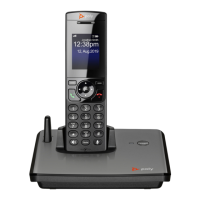Call Routing
39
Rules in the EM or IM state are candidates to be selected by the DMP. After processing a new digit, the DMP
returns a final decision if any of the following conditions holds:
● All rules are the MM state. The DMP returns an error.
● One or more rules are in the EM state with no rules in the IM state. DMP returns the best matched
EM rule. If the best matched rule is a barring rule, DMP returns an error instead.
Otherwise, DMP starts the short interdigit timer if there is at least one rule in the EM state, or else the long
one. When the interdigit timer expires, DMP makes a timely decision by returning the best matched rule at
that moment if one is found, or else a timeout error. Again if the best matched rule in this case is a barring
rule, DMP returns an error instead. Note that the timer to wait for the first input digit isn’t governed by the
interdigit timer, but the duration of dial tone being played and could be a lot lengthier than the long interdigit
timer.
The best matched rule is the one that has the most specific literals matching the input digit sequence. For
example, the input sequence 1234 matches the rule 123x better than 1xxx. On the other hand, an EM rule
is always selected over an IM rule.
Finally, the default interdigit timer can be overridden by appending the Sn element at the end of the rule (n
= 0–9).
Consider this simple digit map:
(<1408>xxx xxxx)
As soon as you enter 7 digits, the DMP returns a complete number by prepending the accumulated digits
with 1408.
Consider another simple map:
(xx.)
After you dial one or more digits, the DMP returns the accumulated digits as a complete number when the
long interdigit timer expires.
Combine the last two maps:
(xx. | <1408>xxx xxxx)
After you dial one or more digits (but fewer than seven digits), the DMP returns the accumulated digits as a
complete number when the (long) interdigit timer expires. As soon as seven digits are entered, the DMP
returns 1408 followed by the accumulated seven digits when the (short) interdigit expires. On the eighth digit
and beyond, however, the DMP considers the first rule only and returns the accumulated digits as-is when
the (long) interdigit timer expires.
Now add an S4 timer to the second rule:
(xx. | <1408>xxx xxxxS4)
In this case, the DMP behaves exactly the same as the last, except that the short interdigit timer the DMP
uses upon receiving the seventh digit is overridden by a 4-second timer. Thus you’ve as long as 4 seconds
instead of 2 to dial the eighth digit.
Force an Interdigit Timeout with a Pound(#) Key
When dialing, you can force an interdigit timeout with a # key instead of waiting for the DMP to timeout its
own long or short timer. This is allowed as long as the # key doesn’t match the current element of any PM
rules. Otherwise the DMP consumes the # key instead of triggering a timeout.
Consider the digit map (33xx.)

